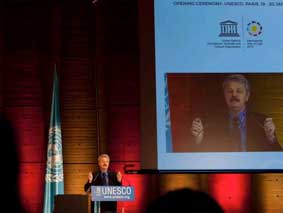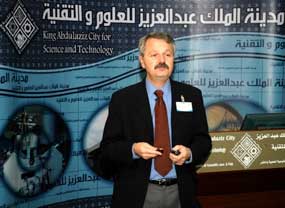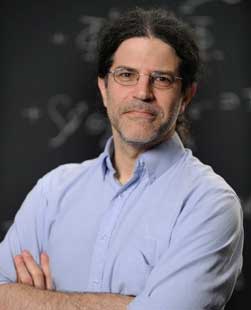Spotlights on Outreach and Engaging the Public
FOEP’s 2015 Dwight Nicholson Awards for Outreach
Questions and Answers with FOEP’s two 2015 Nicholson awardees, Charles Falco and David Kaplan. Answers are edited for brevity and clarity as needed.
Charles M. Falco, University of Arizona
Charles was awarded "for his award-winning "The Art of the Motorcycle" exhibition for the Solomon R. Guggenheim Museum (co-curator), and his work with the renowned artist David Hockney on the optical science utilized by the grand master artists; each unique project has made the public aware of the contributions of science to their daily lives."
Q. How did you get involved in outreach?
A. I'm not sure the present concept of outreach even existed when I first found myself involved in it by judging a science fair when I was a graduate student. I hadn't even volunteered, but rather it was foisted on me by one of the professors. However, it turned out to be a very positive experience that showed me there was a need for, and genuine appreciation of, outreach activities. That initial exposure was the trigger that led to my increasing involvement in activities to show the importance of science to the general public.
Q. What do you find most exciting about outreach?
A. Let me answer this with an example. Some time ago I gave two talks at the University of Illinois, a condensed matter seminar one day and a public lecture on my work with David Hockney another. Illinois has a large condensed matter program so ~30 people attended my seminar, after which there were a couple of polite questions and it was over. However, since all of them already knew a great deal of physics my seminar increased their total knowledge of the subject by epsilon. In contrast, the auditorium for my public lecture had hundreds of people, nearly all of whom stayed for the question period until finally the host had to cut things off nearly an hour later. Further, the discoveries about art and optics I described changed their understanding by a significant amount. For me, what's exciting about outreach is that in a given amount of time I can reach a much greater number of people, and I can have a much bigger effect on each of them, than when giving a research talk to an audience of scientists.
Q. Is it difficult to juggle your scientific research in condensed matter physics and continue to do outreach projects?
A. I've been asked that before, and I still don't have a good answer. Although the time I spend, say, working with David Hockney is time I don't spend doing condensed matter physics, my research in that area has been continuously funded since graduate school. However, what I can't quantify is how the insights I get from someone like him improve, change, affect, etc. the physics I do. I personally have no doubt that there has been a positive effect of my outreach activities on my scientific research.
As for whether it is "difficult," the answer is 'no' because I haven't consciously struggled to juggle things. I've been lucky to be able to pursue whatever has most interested me, in and out of physics, and obtained outcomes that other people find interesting as well. As an example of not juggling, on a trip to speak at a scientific conference in Canberra earlier this year I also gave public lectures at the National Gallery of Australia, and to a large gathering of regional motorcycle clubs. I didn't have to juggle between activities since I could do all three.
Q. You’ve given over 400 invited talks in 32 countries. What were your favorite and worst experiences? What is your impression of the impact you are having on the global community?
A. I've been to a lot of interesting places so it's hard to limit this to just one story, but one set of memorable experiences happened within a few weeks of each other in the early 1990s. I had been at a two-week conference on the Greek island of Mikonos where the surroundings and the scientific program were excellent. However, my hotel room had no A/C and the shower was basically salt water. On a 10 point scale it was a 1 since it was the worst conference experience I had had up to that time. However, a few weeks later, after a long set of flights followed by an overnight train that took eight hours to cover just 200 miles, I found myself at a conference in a former Young Pioneers camp in Russia. There was no coffee, no heat, no indoor plumbing, and no just about anything else. Mykonos moved up the scale to an 8 after Russia. The moral of this is, no matter how bad you think it is you should make the best of it because it could be a lot worse.
Impact is something that is impossible for me to quantify. However, another story illustrates why I have the impression the impact is significant. I gave a public lecture at the Guggenheim Bilbao (Spain) as part of their 5th Anniversary celebration. After the question and answer period ended, when the person who did the simultaneous translation came to retrieve my headset, he told me that he had worked at the museum from the beginning and this was only the second time the auditorium had been filled. I asked him what had been the other time. Ironically, it had been when Dennis Hopper spoke at the opening of 'The Art of the Motorcycle'.

“I personally have no doubt that there has been a positive effect of my outreach activities on my scientific research.”

“...three bits of advice are: have an interesting story to tell; practice on ever larger audiences to refine your ability to tell that story in the most interesting way; and cultivate contacts outside your scientific world to increase the chances that opportunities to engage the public will be brought to your attention.”
Q. How did you get involved in the Motorcycle exhibit? In art?
A. I'm an academic, so of course I like books. I also like motorcycles, so taken together it's not surprising I like motorcycle books. It turns out I've collected what is probably the world's largest private collection of English-language motorcycle books (and a lot in other languages), with over 90% published since 1897. Making a long story short, when the Director of the Guggenheim had the idea of doing an exhibition on "The Art of the Motorcycle" he needed it curated and I'm probably the closest thing to a "motorcycle scholar" one could hope to find.
I've been very interested in photography since elementary school so my involvement in art goes back a long way. By Jr. High I had built my own enlarger from an old bellows camera and started working with alternative photographic processes. By high school I was making stop-motion 8 mm movies and experimenting with infrared film and silk screening. A few years ago the art critic for 'The New Yorker' wrote, "An efficient test of where you stand on contemporary art is whether you are persuaded, or persuadable, that Chris Burden is a good artist. I think he's pretty great." In graduate school I took part in one of Chris's performance art pieces ('220') and helped him with several others.
Q. If you could give only three bits of advice to scientists on how to engage the public, what advice would you give?
A. This is your toughest question since my activities that have had the greatest impact on the public came about totally through luck. And preparation. My lifelong "academic" interest in motorcycles had given me the background necessary to curate the exhibition at the Guggenheim, but it was through luck that the Director found me. My lifelong interest in art gave me the background to effectively communicate and collaborate with David Hockey, but it was through luck that we were put in contact. But, to try to answer your question, my three bits of advice are: have an interesting story to tell; practice on ever larger audiences to refine your ability to tell that story in the most interesting way; and cultivate contacts outside your scientific world to increase the chances that opportunities to engage the public will be brought to your attention.

David Elazzar Kaplan, Johns Hopkins University
David was awarded "for his extraordinarily innovative and effective efforts in public outreach, and in particular for his production of the documentary film, Particle Fever, that allows nonscientists to experience the scientific world and discoveries as they really are."
Q. How did you get involved in outreach and in making a documentary film?
A. I didn't think of it as 'outreach'. I had been talking about what was going on in the field of particle physics to my friends and family for years and one of them thought it was so dramatic, it should be recorded somehow. I decided to do just that -- more of a history of science project, not communication. So I started interviewing people asking what they thought would happen when the Large Hadron Collider turned on. Another friend said I should record the interviews on film....
At that point I decided to make it a documentary film. I actually started as a film major in college and then switched to physics (and transferred to UC Berkeley) because I thought I would never make it in film, and I liked physics.
I bought myself a camera sometime around 2006 and started interviewing people. The quality was terrible, and my sister suggested I talk to a TV director in NYC that she thought I would love. She was right, and (using half of my Sloan Fellowship), I paid him and his team to make an 8-minute teaser to help raise money for the larger film.
A very long story later (and a different director, multiple producers, years of fundraising, two cinematographers, two editors, and some of the most difficult years of my life), we finished a film.
Q. What was the most unexpected things you learned in film making? The most fun? The hardest? What was the worst experience in film making?
A. There were some great experiences along the way, but making the film was very painful. I tried to do it part time for the first number of years, and things often went badly. The director and I had a very poor relationship. I felt my vision was disrespected, and eventually, I had enough money to hire an editor so another 'set of eyes' would be watching the process. I felt vindicated a number of times along the way, but I still harbor resentment. It was an ugly process, and I know much more now than I did then. But what I really learned is that I don't want to make movies for a living -- I want to make discoveries. That's what I want to struggle with, and what I want to dream about at night.
It is important that, whatever you choose to do with your life, you like the grunt work. There is grunt work in physics, like anything else, and I like it a lot. I can't even help myself but do it.
Q. Is it difficult to juggle your scientific research and continue to do outreach projects?
A. It is nearly impossible. You can only do one thing really well at a time. Right now, I am dedicated to physics. I have an outreach project I want to do, but I doubt I will be able to do it. I am not a perfectionist, but I am almost never satisfied with what I have accomplished, and keep wanting to do better.
Q. How do you think you’ve affected the general public with your outreach efforts?
A. We have been able to estimate that at least 1.5 million people have seen Particle Fever, and probably closer to 2 million. People recognize me on the street and tell me how moved they were by the film. Some have even told me they changed their careers or switched their college major or simply became more motivated in their research because of the movie. More than once after a screening and Q&A, a young teenager, usually female, would ask how she can pursue physics. At film festivals, people who have never thought they would have any interest in physics were crying by the end of the film.
That's what I know. It seems like it 'worked', whatever that means.
Q. In the film you point out how science brings together people of all sorts of backgrounds, including those who come from countries with long standing tensions. It resonated with me. That led me to wonder if your display of this very international group of scientists, this world effort of discovery, had an impact on the international community. I don’t know how you would measure that, but it seems you do have some evidence on how your film impacted the general public and their views on science.
A. I don't really know how I would measure the global impact. The cooperation is definitely something that inspires me, which is why I wanted it emphasized in the film.
Q. Do you think scientists should make sharing their research to a general audience a personal story, or should they try to remove personal biases and let impartial facts speak for themselves?
A. I think being rational and logical are obviously critical. Attempting to apply that attitude at all times I think is a good thing. Sometimes, it is not possible, and it is in those moments of failure when we feel inspired. Discoveries are hard because they are non-intuitive — otherwise, they would have been made already!
I think it is good for a scientist to dig deep and understand why they are doing the work they are doing. Even if it means years of self-doubt. That questioning is part of being rigorous. We should not have pat answers as to why our work is important — it should be real, and if we aren't really sure, then that's the answer.
I am not very interested in the training of scientists to be more 'personal'. I think it should come from the opposite side. I had my original production team (before Mark Levinson and company) make a short video about a physicist, Kyle Cranmer of NYU. They started interviewing him, and let him talk physics, as technical as he wanted, for an hour before asking personal questions. After that hour, Kyle was completely in his comfort zone, and all of the personal feelings came out.
You see, the people recording and interviewing physicists often think the work is impersonal and look for an angle. But in fact, it is the work itself that makes us so passionate. When we are pushed to explain it to the public, it is hard work, and often that effort masks our true joy in doing it. But I now realize there are techniques to extract the real feelings from scientists — deep feelings that we all have in different ways.
Humans are complicated. I believe our job is to inspire others and to be humble. Eloquence helps bring people along. Humility reminds you that we are in the ‘truth business,’† and we should check in with the truth as often as possible.
Q. If you could give only three bits of advice to scientists on how to engage the public, what advice would you give?
A. Only one piece of advice. Do it because you can't help yourself — not because you think you have to.
†’Truth business’ is a common phrase used by Dr. Savas Dimopoulos, who is featured in Particle Fever.
H.M. Doss

“...what I really learned is that I don't want to make movies for a living — I want to make discoveries. That's what I want to struggle with, and what I want to dream about at night.”
“It is important that, whatever you choose to do with your life, you like the grunt work. There is grunt work in physics, like anything else, and I like it a lot. I can't even help myself but do it.”
“Humans are complicated. I believe our job is to inspire others and to be humble. Eloquence helps bring people along. Humility reminds you that we are in the ‘truth business,’† and we should check in with the truth as often as possible.”
